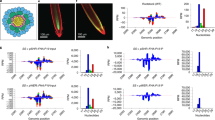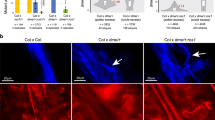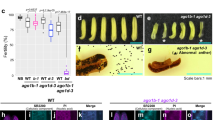Abstract
Plant small interfering RNAs (siRNAs) communicate from cell to cell and travel long distances through the vasculature. However, siRNA movement into germ cells has remained controversial, and has gained interest because the terminally differentiated pollen vegetative nurse cell surrounding the sperm cells undergoes a programmed heterochromatin decondensation and transcriptional reactivation of transposable elements (TEs). Transcription of TEs leads to their post-transcriptional degradation into siRNAs, and it has been proposed that the purpose of this TE reactivation is to generate and load TE siRNAs into the sperm cells. Here, we identify the molecular pathway of TE siRNA production in the pollen grain and demonstrate that siRNAs produced from pollen vegetative cell transcripts can silence TE reporters in the sperm cells. Our data demonstrates that TE siRNAs act non-cell-autonomously, inhibiting TE activity in the germ cells and potentially the next generation.
This is a preview of subscription content, access via your institution
Access options
Subscribe to this journal
Receive 12 digital issues and online access to articles
$119.00 per year
only $9.92 per issue
Buy this article
- Purchase on Springer Link
- Instant access to full article PDF
Prices may be subject to local taxes which are calculated during checkout




Similar content being viewed by others
References
Fultz, D., Choudury, S. G. & Slotkin, R. K. Silencing of active transposable elements in plants. Curr. Opin. Plant Biol. 27, 67–76 (2015).
McCue, A. D., Nuthikattu, S., Reeder, S. H. & Slotkin, R. K. Gene expression and stress response mediated by the epigenetic regulation of a transposable element small RNA. PLoS Genet. 8, e1002474 (2012).
Sarkies, P. et al. Ancient and novel small RNA pathways compensate for the loss of piRNAs in multiple independent nematode lineages. PLoS Biol. 13, e1002061 (2015).
Molnar, A. et al. Small silencing RNAs in plants are mobile and direct epigenetic modification in recipient cells. Science 328, 872–875 (2010).
Lewsey, M. G. et al. Mobile small RNAs regulate genome-wide DNA methylation. Proc. Natl Acad. Sci. USA 113, 801–810 (2016).
Voinnet, O., Vain, P., Angell, S. & Baulcombe, D. C. Systemic spread of sequence-specific transgene RNA degradation in plants is initiated by localized introduction of ectopic promoterless DNA. Cell 95, 177–187 (1998).
Melnyk, C. W., Molnar, A. & Baulcombe, D. C. Intercellular and systemic movement of RNA silencing signals. EMBO J. 30, 3553–3563 (2011).
Grant-Downton, R. et al. Artificial microRNAs reveal cell-specific differences in small RNA activity in pollen. Curr. Biol. 23, R599–R601 (2013).
Kawashima, T. & Berger, F. Epigenetic reprogramming in plant sexual reproduction. Nature Rev. Genet. 15, 613–624 (2014).
Schoft, V. K. et al. Induction of RNA-directed DNA methylation upon decondensation of constitutive heterochromatin. EMBO Rep. 10, 1015–1021 (2009).
Borg, M. & Berger, F. Chromatin remodelling during male gametophyte development. Plant J. 83, 177–188 (2015).
Slotkin, R. K. et al. Epigenetic reprogramming and small RNA silencing of transposable elements in pollen. Cell 136, 461–472 (2009).
Schmitz, R. J. et al. Patterns of population epigenomic diversity. Nature 495, 193–198 (2013).
Martinez, G. & Slotkin, R. K. Developmental relaxation of transposable element silencing in plants: functional or byproduct? Curr. Opin. Plant Biol. 15, 496–502 (2012).
Bourc'his, D. & Voinnet, O. A small-RNA perspective on gametogenesis, fertilization, and early zygotic development. Science 330, 617–622 (2010).
Ibarra, C. A. et al. Active DNA demethylation in plant companion cells reinforces transposon methylation in gametes. Science 337, 1360–1364 (2012).
Brennecke, J. et al. An epigenetic role for maternally inherited piRNAs in transposon silencing. Science 322, 1387–1392 (2008).
Malone, C. D. et al. Specialized piRNA pathways act in germline and somatic tissues of the Drosophila ovary. Cell 137, 522–535 (2009).
Allen, E., Xie, Z., Gustafson, A. M. & Carrington, J. C. microRNA-directed phasing during trans-acting siRNA biogenesis in plants. Cell 121, 207–221 (2005).
de Felippes, F. F., Ott, F. & Weigel, D. Comparative analysis of non-autonomous effects of tasiRNAs and miRNAs in Arabidopsis thaliana. Nucleic Acids Res. 39, 2880–2889 (2011).
Kim, H. J. et al. Control of plant germline proliferation by SCF(FBL17) degradation of cell cycle inhibitors. Nature 455, 1134–1137 (2008).
Okada, T., Endo, M., Singh, M. B. & Bhalla, P. L. Analysis of the histone H3 gene family in Arabidopsis and identification of the male-gamete-specific variant AtMGH3. Plant J. 44, 557–568 (2005).
Borges, F. et al. FACS-based purification of Arabidopsis microspores, sperm cells and vegetative nuclei. Plant Methods 8, 44 (2012).
Honys, D. & Twell, D. Transcriptome analysis of haploid male gametophyte development in Arabidopsis. Genome Biol. 5, R85 (2004).
Nodine, M. D. & Bartel, D. P. MicroRNAs prevent precocious gene expression and enable pattern formation during plant embryogenesis. Genes Dev. 24, 2678–2692 (2010).
Borges, F., Pereira, P. A., Slotkin, R. K., Martienssen, R. A. & Becker, J. D. MicroRNA activity in the Arabidopsis male germline. J. Exp. Bot. 62, 1611–1620 (2011).
Grant-Downton, R. et al. MicroRNA and tasiRNA diversity in mature pollen of Arabidopsis thaliana. BMC Genomics 10, 643 (2009).
Mari-Ordonez, A. et al. Reconstructing de novo silencing of an active plant retrotransposon. Nature Genet. 45, 1029–1039 (2013).
Zilberman, D., Cao, X. & Jacobsen, S. E. ARGONAUTE4 control of locus-specific siRNA accumulation and DNA and histone methylation. Science 299, 716–719 (2003).
Xie, Z., Allen, E., Wilken, A. & Carrington, J. C. DICER-LIKE 4 functions in trans-acting small interfering RNA biogenesis and vegetative phase change in Arabidopsis thaliana. Proc. Natl Acad. Sci. USA 102, 12984–12989 (2005).
Dunoyer, P., Himber, C. & Voinnet, O. DICER-LIKE 4 is required for RNA interference and produces the 21-nucleotide small interfering RNA component of the plant cell-to-cell silencing signal. Nature Genet. 37, 1356–1360 (2005).
Gasciolli, V., Mallory, A. C., Bartel, D. P. & Vaucheret, H. Partially redundant functions of Arabidopsis DICER-like enzymes and a role for DCL4 in producing trans-acting siRNAs. Curr. Biol. 15, 1494–1500 (2005).
Montgomery, T. A. et al. AGO1-miR173 complex initiates phased siRNA formation in plants. Proc. Natl Acad. Sci. USA 105, 20055–20062 (2008).
Manavella, P. A., Koenig, D. & Weigel, D. Plant secondary siRNA production determined by microRNA-duplex structure. Proc. Natl Acad. Sci. USA 109, 2461–2466 (2012).
Chen, H. M. et al. 22-Nucleotide RNAs trigger secondary siRNA biogenesis in plants. Proc. Natl Acad. Sci. USA 107, 15269–15274 (2010).
Axtell, M. J., Jan, C., Rajagopalan, R. & Bartel, D. P. A two-hit trigger for siRNA biogenesis in plants. Cell 127, 565–577 (2006).
Ye, R. et al. A dicer-independent route for biogenesis of siRNAs that direct DNA methylation in Arabidopsis. Mol. Cell. 61, 222–235 (2016).
Cuperus, J. T. et al. Unique functionality of 22-nt miRNAs in triggering RDR6-dependent siRNA biogenesis from target transcripts in Arabidopsis. Nature Struct. Mol. Biol. 17, 997–1003 (2010).
Gonzalez, I. et al. Cucumber mosaic virus 2b protein subcellular targets and interactions: their significance to RNA silencing suppressor activity. Mol. Plant Microbe Interact. 23, 294–303 (2010).
Hamera, S., Song, X., Su, L., Chen, X. & Fang, R. Cucumber mosaic virus suppressor 2b binds to AGO4-related small RNAs and impairs AGO4 activities. Plant J. 69, 104–115 (2012).
Borges, F. et al. Comparative transcriptomics of Arabidopsis sperm cells. Plant Physiol. 148, 1168–1181 (2008).
Zhai, J. et al. Spatiotemporally dynamic, cell-type-dependent premeiotic and meiotic phasiRNAs in maize anthers. Proc. Natl Acad. Sci. USA 112, 3146–3151 (2015).
Tarutani, Y. et al. Trans-acting small RNA determines dominance relationships in Brassica self-incompatibility. Nature 466, 983–986 (2010).
Nuthikattu, S. et al. The initiation of epigenetic silencing of active transposable elements is triggered by RDR6 and 21-22 nucleotide small interfering RNAs. Plant Physiol. 162, 116–131 (2013).
McCue, A. D. et al. ARGONAUTE 6 bridges transposable element mRNA-derived siRNAs to the establishment of DNA methylation. EMBO J. 34, 20–35 (2015).
Calarco, J. P. et al. Reprogramming of DNA methylation in pollen guides epigenetic inheritance via small RNA. Cell 151, 194–205 (2012).
Lucy, A. P., Guo, H. S., Li, W. X. & Ding, S. W. Suppression of post-transcriptional gene silencing by a plant viral protein localized in the nucleus. EMBO J. 19, 1672–1680 (2000).
McCue, A. D., Cresti, M., Feijo, J. A. & Slotkin, R. K. Cytoplasmic connection of sperm cells to the pollen vegetative cell nucleus: potential roles of the male germ unit revisited. J. Exp. Bot. 62, 1621–1631 (2011).
Stocks, M. B. et al. The UEA sRNA workbench: a suite of tools for analysing and visualizing next generation sequencing microRNA and small RNA datasets. Bioinformatics 28, 2059–2061 (2012).
Chen, H. M., Li, Y. H. & Wu, S. H. Bioinformatic prediction and experimental validation of a microRNA-directed tandem trans-acting siRNA cascade in Arabidopsis. Proc. Natl Acad. Sci. USA 104, 3318–3323 (2007).
Acknowledgements
The authors thank C. DeFraia for his data contributions, F. Qu for the 2b clone and J. Daron for assistance with data analysis. The authors also thank A. Dobritsa, A. McCue, M. Mirouze and X. Zhou for their comments. G.M. is supported by a Marie Curie IOF Postdoctoral Fellowship (PIOF-GA-2012-330069). This research was supported by NSF grants MCB-1020499 and MCB-1252370 to R.K.S.
Author information
Authors and Affiliations
Contributions
G.M. and R.K.S. devised the experimental approach. G.M. performed the experimental work, generated transgenic lines, sequencing libraries and performed the data analysis. K.P. analysed the small RNA data. R.K.S, C.K. and G.M. wrote the paper.
Corresponding author
Ethics declarations
Competing interests
The authors declare no competing financial interests.
Rights and permissions
About this article
Cite this article
Martínez, G., Panda, K., Köhler, C. et al. Silencing in sperm cells is directed by RNA movement from the surrounding nurse cell. Nature Plants 2, 16030 (2016). https://doi.org/10.1038/nplants.2016.30
Received:
Accepted:
Published:
DOI: https://doi.org/10.1038/nplants.2016.30
This article is cited by
-
Soma-to-germline RNA communication
Nature Reviews Genetics (2022)
-
Plant and animal small RNA communications between cells and organisms
Nature Reviews Molecular Cell Biology (2022)
-
Embryo CHH hypermethylation is mediated by RdDM and is autonomously directed in Brassica rapa
Genome Biology (2021)
-
Male fertility in Arabidopsis requires active DNA demethylation of genes that control pollen tube function
Nature Communications (2021)
-
Persistent directional growth capability in Arabidopsis thaliana pollen tubes after nuclear elimination from the apex
Nature Communications (2021)



